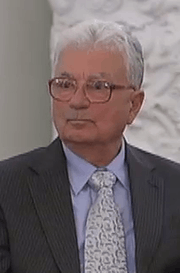Yuri Oganessian
| Yuri Oganessian | |
|---|---|
|
Yuri Oganessian in 2011 | |
| Born |
April 14, 1933 Rostov-on-Don, Soviet Union |
| Nationality | Russian |
| Fields | Nuclear physics |
| Institutions | Flerov Laboratory of Nuclear Reactions |
| Alma mater | Moscow Engineering Physics Institute |
| Known for | Co-discoverer of the heaviest elements in the periodic table; element oganesson named after him |
Yuri Tsolakovich Oganessian (Russian: Ю́рий Цола́кович Оганеся́н, Armenian: Յուրի Ցոլակի Հովհաննիսյան; born 14 April 1933) is a Rostov-on-Don-born Russian nuclear physicist of Armenian descent.[1] He and his team discovered the heaviest elements in the periodic table.[2][3]
Oganessian became the world's leading researcher in superheavy elements and the island of stability. At age 28, he joined the group of Georgy Flyorov (Flerov) at the Joint Institute for Nuclear Research in Dubna.[4] Today Oganessian is the scientific leader of the Flerov Laboratory of Nuclear Reactions (FLNR).[5] He invented cold fusion around 1970 and pioneered hot fusion in the late 1990s.[4] In 2009, scientists in the United States confirmed Oganessian's team's discovery of flerovium over a decade before.[6] He continues to search for superheavy elements in nature, which he thinks might be found in meteorites.[4]
In November, 2016, IUPAC announced that element 118 be named oganesson to honor Oganessian.[7][8][9] Prior to this announcement, a dozen elements had been named after people,[10] but of those, only seaborgium was likewise named while the person (Glenn Seaborg) was alive.
References
- ↑ "New Element In Periodic Table To Be Named After Armenian Physicist". Asbarez. 9 June 2016.
- ↑ "EPS introduces new Lise Meitner prize". CERN Courier. IOP Publishing. April 2, 2001.
- ↑ "Yuri Tsolakovich Oganessian". Flerov Laboratory of Nuclear Reactions. Retrieved December 3, 2016 – via Internet Archive.
- 1 2 3 Chapman, Kit (November 30, 2016). "What it takes to make a new element". Chemistry World. Royal Society of Chemistry. Retrieved December 3, 2016.
- ↑ "FLNR Directorate". Retrieved October 16, 2013.
- ↑ "Element 114 confirmed". Royal Society of Chemistry. 30 September 2009. Retrieved 19 November 2011.
- ↑ "Periodic Table of Elements". IUPAC. 2016-11-28.
- ↑ "IUAPC announces the names of the elements 113-115-117-118". IUPAC. 2016-11-30.
- ↑ "Names proposed for new chemical elements". BBC News. 8 June 2016.
- ↑ 12 other elements named in honor of people are:
Curium, Einsteinium, Fermium, Mendelevium, Nobelium, Lawrencium, Rutherfordium, Seaborgium, Bohrium, Meitnerium, Roentgenium, Copernicium
(5 more were named for places/things that had been named after people:
Samarium, Gadolinium, Berkelium, Flerovium, Livermorium)
